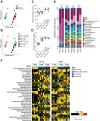It's the fiber, not the fat: significant effects of dietary challenge on the gut microbiome
- PMID: 32046785
- PMCID: PMC7014620
- DOI: 10.1186/s40168-020-0791-6
It's the fiber, not the fat: significant effects of dietary challenge on the gut microbiome
Abstract
Background: Dietary effects on the gut microbiome play key roles in the pathophysiology of inflammatory disorders, metabolic syndrome, obesity, and behavioral dysregulation. Often overlooked in such studies is the consideration that experimental diets vary significantly in the proportion and source of their dietary fiber. Commonly, treatment comparisons are made between animals fed a purchased refined diet that lacks soluble fiber and animals fed a standard vivarium-provided chow diet that contains a rich source of soluble fiber. Despite the well-established critical role of soluble fiber as the source of short chain fatty acid production via the gut microbiome, the extent to which measured outcomes are driven by differences in dietary fiber is unclear. Further, the interaction between sex and age in response to dietary transition is likely important and should also be considered.
Results: We compared the impact of transitioning young adult and 1-year aged male and female mice from their standard chow diet to a refined low soluble fiber diet on gut microbiota community composition. Then, to determine the contribution of dietary fat, we also examined the impact of transitioning a subset of animals from refined low-fat to refined high-fat diet. We used a serial sampling strategy coupled with 16S rRNA marker gene sequencing to examine consequences of recurrent dietary switching on gut microbiota community dynamics. Analysis revealed that the transition from a chow diet to a refined diet that lacks soluble fiber accounted for most of the variance in community structure, diversity, and composition across all groups. This dietary transition was characterized by a loss of taxa within the phylum Bacteroidetes and expansion of Clostridia and Proteobacteria in a sex- and age-specific manner. Most notably, no changes to gut microbiota community structure and composition were observed between mice consuming either refined low- or high-fat diet, suggesting that transition to the refined diet that lacks soluble fiber is the primary driver of gut microbiota alterations, with limited additional impact of dietary fat on gut microbiota.
Conclusion: Collectively, our results show that the choice of control diet has a significant impact on outcomes and interpretation related to diet effects on gut microbiota. As the reduction of soluble fiber may influence synthesis of microbial metabolites that are important for regulating metabolic, immune, behavioral, and neurobiological outcomes, additional studies are now needed to fully delineate the contribution of fat and fiber on the gut microbiome. Video Abtract.
Keywords: Aging; Diet; Metabolism; Microbiome; Sex differences.
Conflict of interest statement
The authors declare that they have no competing interests.
Figures



Similar articles
-
A High-Fat Diet Increases Gut Microbiota Biodiversity and Energy Expenditure Due to Nutrient Difference.Nutrients. 2020 Oct 20;12(10):3197. doi: 10.3390/nu12103197. Nutrients. 2020. PMID: 33092019 Free PMC article.
-
Dietary Uncoupling of Gut Microbiota and Energy Harvesting from Obesity and Glucose Tolerance in Mice.Cell Rep. 2017 Nov 7;21(6):1521-1533. doi: 10.1016/j.celrep.2017.10.056. Cell Rep. 2017. PMID: 29117558 Free PMC article.
-
Soluble Fiber Inulin Consumption Limits Alterations of the Gut Microbiota and Hepatic Fatty Acid Metabolism Caused by High-Fat Diet.Nutrients. 2021 Mar 23;13(3):1037. doi: 10.3390/nu13031037. Nutrients. 2021. PMID: 33806985 Free PMC article.
-
Gut microbiota and associated metabolites: key players in high-fat diet-induced chronic diseases.Gut Microbes. 2025 Dec;17(1):2494703. doi: 10.1080/19490976.2025.2494703. Epub 2025 Apr 22. Gut Microbes. 2025. PMID: 40260760 Free PMC article. Review.
-
Review of the Relationships Between Human Gut Microbiome, Diet, and Obesity.Nutrients. 2024 Nov 22;16(23):3996. doi: 10.3390/nu16233996. Nutrients. 2024. PMID: 39683390 Free PMC article. Review.
Cited by
-
Does an Apple a Day Also Keep the Microbes Away? The Interplay Between Diet, Microbiota, and Host Defense Peptides at the Intestinal Mucosal Barrier.Front Immunol. 2020 Jun 9;11:1164. doi: 10.3389/fimmu.2020.01164. eCollection 2020. Front Immunol. 2020. PMID: 32655555 Free PMC article. Review.
-
Animal models built for women's brain health: Progress and potential.Front Neuroendocrinol. 2020 Oct;59:100872. doi: 10.1016/j.yfrne.2020.100872. Epub 2020 Sep 19. Front Neuroendocrinol. 2020. PMID: 32961121 Free PMC article. Review.
-
Dietary Fiber Intake and Femoral Bone Mineral Density in Middle-Aged and Older US Adults: A Cross-Sectional Study of National Health and Nutrition Examination Survey 2013-2014.Front Nutr. 2022 Mar 14;9:851820. doi: 10.3389/fnut.2022.851820. eCollection 2022. Front Nutr. 2022. PMID: 35360698 Free PMC article.
-
Gene-by-environment modulation of lifespan and weight gain in the murine BXD family.Nat Metab. 2021 Sep;3(9):1217-1227. doi: 10.1038/s42255-021-00449-w. Epub 2021 Sep 22. Nat Metab. 2021. PMID: 34552269 Free PMC article.
-
Diversity and dynamism of IgA-microbiota interactions.Nat Rev Immunol. 2021 Aug;21(8):514-525. doi: 10.1038/s41577-021-00506-1. Epub 2021 Feb 10. Nat Rev Immunol. 2021. PMID: 33568782 Review.
References
-
- Diet, nutrition, and the prevention of chronic diseases: report of a WHO-FAO Expert Consultation ; [Joint WHO-FAO Expert Consultation on Diet, Nutrition, and the Prevention of Chronic Diseases, 2002, Geneva, Switzerland]. (World Health Organization, 2003).
Publication types
MeSH terms
Substances
Grants and funding
LinkOut - more resources
Full Text Sources
Medical
Research Materials

